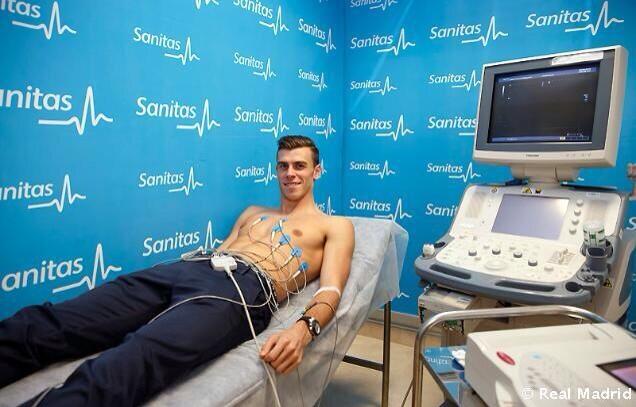When a footballer is about to join a new club, he will undergo a medical test. This is one of the final steps in the transfer process, it usually means the deal is about to be sealed.
In a medical test, the purchasing club wants to discover the shape and fitness of their new recruit. They also want to ascertain if there are any underlying conditions that could lead to injury in the future.
So, any player seeking for a transfer will have to prove to potential new employers that he is ready to hit the ground running and won’t spend huge amount of time in the treatment room.
When the fees for a transfer have been agreed and the personal terms have been sorted, the final hurdle in negotiations is a player’s medical examination.
The medical test is a standard part of the transfer process in soccer. In this article, FootballOrbit looks at what actually goes on in the test?
What is a medical test in football?
Generally, a medical test/examination is the set of tests focused on the investigation of possible injuries, alterations or organic anomalies.
Normally, a cardio-respiratory medical examination, muscle mass, body mass, etc. are done first.
Once the general examinations have been completed, more specific tests are carried out for organs and also hearing, sight, balance, and the locomotor.
Every football player is different, hence, there is no standard medical checkup for every club. Clubs are free to follow their own procedures and usually have their own way of doing things.
Each player has his own health issue(s) and the medical test is designed to ensure that these won’t stop him from performing at his peak.
Another factor is the position that the potential new signing is set to take. For example, a goalkeeper’s medical will be different to that of a striker as there will be a greater emphasis on a ‘keeper’s upper body.
Clubs can take up to 2-3 days to conduct a medical, which is carried out by a club doctor, a physiotherapist and a fitness team.
Once the result is out, the information is passed onto the manager and the board before a decision is taken.
In the past, the medical was a mere formality and is often over in less than a couple of hours. But nowadays, with huge transfer fees being paid on players; the process has become more rigorous.
Basically, a player doesn’t actually “pass” or “fail” a medical. It depends on standards set by clubs as regards fitness, and how much risk they could take.
Doctors analyse the inherent risks and inform the manager, board and stakeholders of the buying club; who then decide whether to proceed with a transfer or not.
In some cases, a club may sign a player even if there are signs of health issues that may lead to future injuries — if they are desperate to get the player.
Other times, there are clubs willing to buy an injured player because their medical staff believe that it is something they can treat within a few months and will be a good investment in the future.
Processes involved in a football medical test

The first part of a football medical will be taken by the club doctor, who will establish the player’s medical history while examining him.
To help with this, the buying club will receive the player’s medical history from the selling team.
Afterwards, a thorough examination is conducted. This includes MRI scans, X-ray tests or a full musculoskeletal ultrasound.
A thorough physical test will include a check of all muscles and joints. The medical professionals will assess things like range of motion and muscle strength via isokinetic devices.
Once the musculoskeletal system has been assessed, more routine test such as height, weight, body fat, lung capacity, pulse rate, blood pressure, vision, hearing and dental health are recorded.
Important aspects examined during a medical
Heart health
In this area, there will be a cardiac screening involving an ECG, echo monitor and a check of the player’s history. This could also include urine tests for conditions such as diabetes.
In football, the condition of the heart is of utmost importance. Footballers do a lot of running and are vulnerable to heart attacks.
In March 2012, Fabrice Muamba suffered a cardiac arrest during an FA Cup match between Bolton and Tottenham Hotspur, with his heart stopping for 78 minutes.
Luckily, he recovered.
Following medical advice, he retired 5 months later — joining the list of top footballers that were forced to retire early.
Muamba was lucky to survive, but others such as Marc Vivien Foe and Phil O’Donnell died due to undiagnosed heart problems.
Muscle/Skeleton Stability
This test involves searching for weak spots in the player’s musculoskeletal system, focussing on usual weak spots such as the lower back and pelvic regions, which are often where hamstring problems, both current and future can stem from and be spotted.
Medics look at musculoskeletal stability to determine if a player will have any problems with the quads or hamstrings.
Players will be made to do a number of squats, hop tests and lunges to show that these regions are strong enough for a 50-game plus season.
Hamstring injury is one of the common football injuries that are very terrible.
Furthermore, lower limbs like knee and ankles are the areas that are most commonly injured in soccer.
Isokinetic
This test monitors how the bodies muscles work together, to spot any weaknesses or imbalances, which could be a result of neglect because of an injury lay-off and could indicate a likelihood of injury in the future.
Isokinetics machine will be used to provide data on leg strength and compare any imbalances that may point to a tendency to put more stress on one leg over the other, providing clues as to where injuries could arise in the future.
Scan
If a player has a long injury history, tests such as an ultrasound could be used to spot any potential problems deep in the tissues.
Body Fat
Unlike non-athletes, professional players are expected to be always physically fit and be in good shape.
Most footballers’ body fat is around the 10% mark, so often a test to measure this will be carried out using bioelectrical technology.
Some players may return from a long injury lay-off or from pre-season looking overweight maybe after enjoying too many lagers and BBQs during their absence.
To determine if a player has too much weight during a medical, a technique called Bioelectrical Impedance technology — which scans the body and measures lean tissue and fat — will be used.
Sprint Test
A top level footballer needs to be fast (and sharp) over 90 minutes of football.
The ergometric sprint test lets a team know about a player’s speed over a certain distance.
After the initial football medical test conducted by the club
If a new club has concerns after carrying out an initial medical test on a player with a history of medical issues who is set to join them, it’s likely that such player will need more in-depth testing.
In such case, a trip to the nearest hospital maybe required for an ultrasound scan — or something similar — where state of the art equipment can provide a full picture of the muscles, joints and bones of the player.
What happens when a player “fails” a medical?
The discovery of latent injuries during a medical may lead to transfer deals being scuppered at the last minute, much to the embarrassment of the player and the selling club.
Typically, clubs hastily agree to sign players on transfer deadline day “subject to a medical”. This will allow the deal to go through without the need for the lengthy process.
Should any medical problem(s) arise afterwards, the player may end up being referred to a consultant who will assess him and advise the buying club of his prognosis. Thereafter, the club will decide whether to sign the player or not.
If a player “fails” a medical, it is usually because the buying club deems it unacceptable for them to take a risk on the player.
Moreover, this doesn’t rule out the player’s chances of finding a willing club.
Famously, French attacker Loic Remy was close to making a switch to Liverpool in 2014, only for the Reds to pull the plug on the deal at the last minute because he “failed his medicals”.
Interestingly, just about 4 weeks later, Chelsea signed Remy — with the Blues deeming him to have passed his medical.


